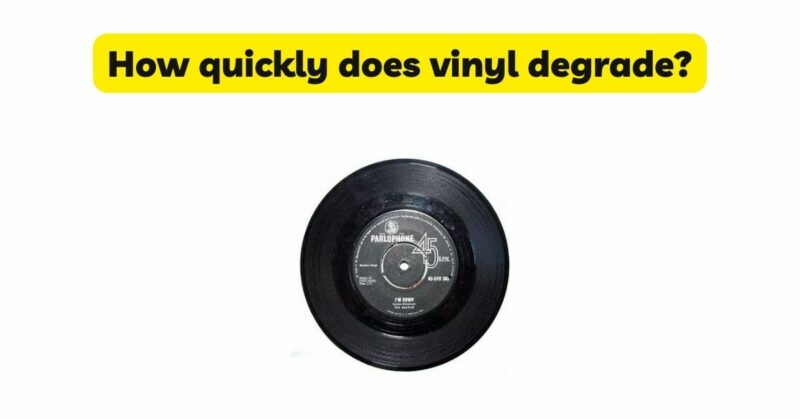Vinyl records have captivated music enthusiasts for decades with their warm sound and tactile experience. However, as cherished as they are, vinyl records are not invincible and can degrade over time. In this article, we will explore the factors that contribute to the degradation of vinyl records and shed light on how quickly this process occurs. By understanding these factors and implementing proper care practices, you can ensure the longevity of your vinyl collection.
- Vinyl’s Longevity and Resilience
Vinyl records are known for their durability and ability to withstand the test of time. Several factors contribute to their longevity:
a) Vinyl Composition: Vinyl records are typically made from polyvinyl chloride (PVC), a robust and flexible material. PVC strikes a balance between strength and flexibility, allowing records to resist physical stress and deformation.
b) Record Pressing Quality: The quality of the pressing process plays a vital role in the longevity of a vinyl record. Well-pressed records with consistent groove depth and appropriate thickness are less prone to degradation.
c) Groove Depth: Vinyl records feature deep grooves that protect the sensitive audio information. The stylus tracks within these grooves, minimizing direct contact with the vinyl surface and reducing wear over time.
d) Vinyl Thickness: The thickness of the vinyl record also contributes to its durability. Thicker vinyl records, often found in high-quality pressings or audiophile releases, offer increased protection against wear and damage.
- Factors Affecting Vinyl Degradation
While vinyl records are designed to last, several factors can contribute to their degradation over time:
a) Environmental Conditions: Vinyl is sensitive to environmental factors such as temperature, humidity, and exposure to sunlight. High temperatures can cause warping or melting of the vinyl, while excessive humidity can lead to mold or mildew growth. Direct sunlight can fade album covers and degrade the vinyl itself.
b) Improper Handling: Mishandling vinyl records can result in scratches, scuffs, or other damage that affects their playability. Dropping records or mishandling them during storage or playback can cause irreparable harm.
c) Stylus Wear: The stylus (needle) used for playback can contribute to vinyl degradation if not properly maintained. A worn or damaged stylus can cause excessive wear on the grooves, resulting in a loss of audio fidelity.
d) Contaminants: Dust, dirt, and other contaminants can accumulate on the surface of vinyl records, affecting their sound quality and causing additional wear during playback.
- Signs of Vinyl Degradation
Vinyl degradation can manifest in various ways, and it’s important to be aware of the signs:
a) Surface Noise: As vinyl records age, surface noise, including pops, crackles, and static, may become more pronounced. This noise is often a result of accumulated dust or wear in the grooves.
b) Worn Grooves: Excessive playback without proper care can lead to worn grooves. This wear can result in a loss of high-frequency detail, reduced dynamics, and an overall degradation of the audio quality.
c) Warping: Vinyl records are susceptible to warping, which can occur due to exposure to high temperatures or improper storage. Warped records may skip or play unevenly, compromising the listening experience.
d) Visible Damage: Scratches, scuffs, and other physical damage on the surface of a vinyl record can affect playback and degrade the sound quality.
- Proper Care and Maintenance
To minimize vinyl degradation and maximize the lifespan of your records, it’s essential to implement proper care and maintenance practices:
a) Storage: Store vinyl records vertically in a cool, dry, and stable environment. Avoid exposure to direct sunlight, extreme temperatures, or high humidity. Use protective inner sleeves and outer jackets to shield records from dust, moisture, and light.
b) Handling: Handle vinyl records with clean hands or wear cotton gloves to prevent the transfer of oils and contaminants. Hold records by the edges and avoid touching the playing surface.
c) Cleaning: Regularly clean vinyl records using a carbon fiber brush or a record cleaning solution to remove dust and debris. A clean record ensures optimal playback and reduces the risk of additional wear.
d) Stylus Maintenance: Maintain a well-aligned and clean stylus. Regularly clean the stylus using a stylus brush or specialized cleaning solution to remove dust and debris. Replace the stylus when it shows signs of wear or damage.
e) Playback Equipment: Use high-quality turntables, tonearms, and cartridges that are properly set up and calibrated. Proper alignment and tracking force ensure accurate playback and minimize unnecessary wear.
- The Lifespan of Vinyl Records
The lifespan of a vinyl record depends on various factors, including the quality of the pressing, care practices, and frequency of playback. Well-maintained records can last for decades and provide countless hours of listening pleasure. However, it’s important to acknowledge that vinyl records are not immortal. Over time, even with proper care, some degradation is inevitable.
Conclusion
Vinyl records are cherished for their timeless appeal and unique listening experience. While they are resilient and designed to withstand the test of time, vinyl records can degrade if not properly cared for. By understanding the factors that contribute to vinyl degradation and implementing proper care practices, you can ensure the longevity of your vinyl collection. With proper handling, maintenance, and a conducive storage environment, your vinyl records can continue to deliver the magic of analog music for years to come.


